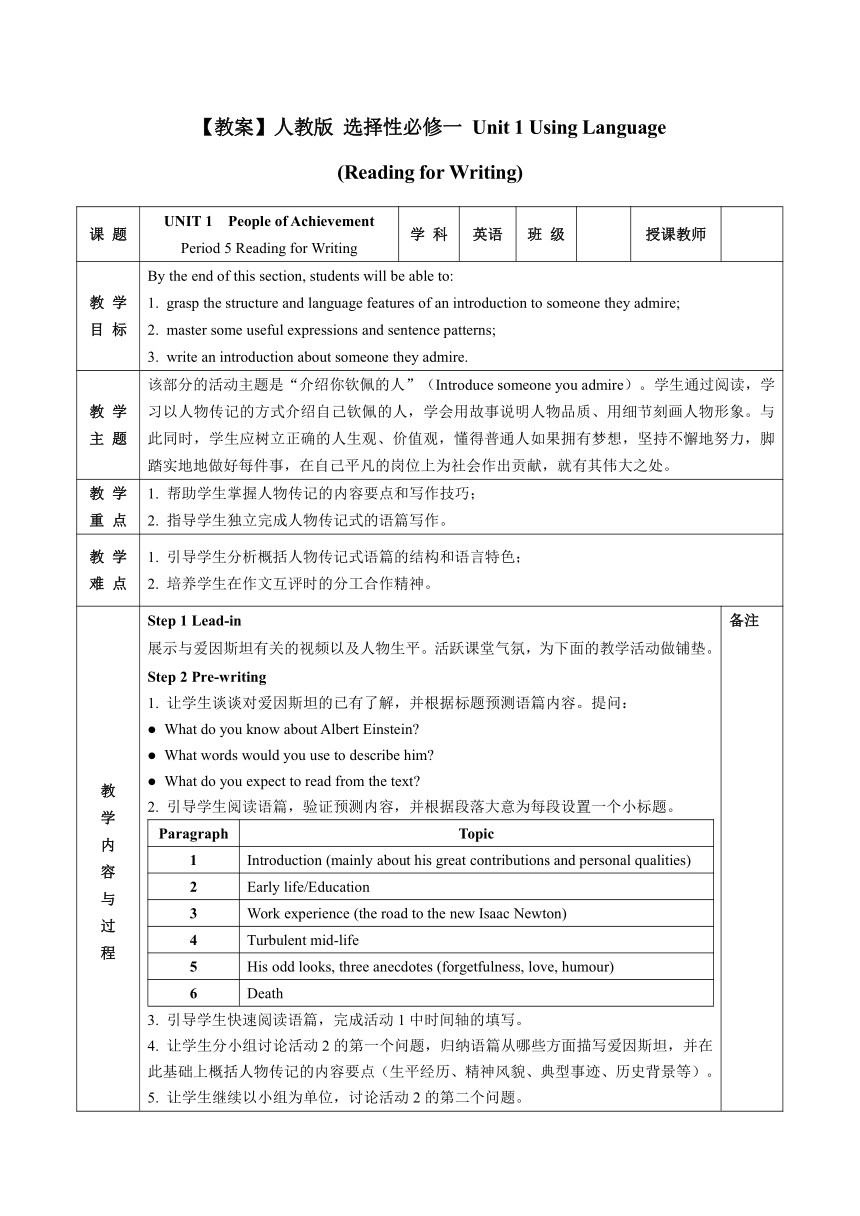人教版 (2019)选择性必修一 Unit 1 People of Achievement Using Language (Reading for Writing)教案(表格式)
文档属性
| 名称 | 人教版 (2019)选择性必修一 Unit 1 People of Achievement Using Language (Reading for Writing)教案(表格式) |

|
|
| 格式 | docx | ||
| 文件大小 | 45.9KB | ||
| 资源类型 | 教案 | ||
| 版本资源 | 人教版(2019) | ||
| 科目 | 英语 | ||
| 更新时间 | 2023-09-03 15:28:29 | ||
图片预览

文档简介
【教案】人教版 选择性必修一 Unit 1 Using Language
(Reading for Writing)
课 题 UNIT 1 People of Achievement Period 5 Reading for Writing 学 科 英语 班 级 授课教师
教 学目 标 By the end of this section, students will be able to: grasp the structure and language features of an introduction to someone they admire; master some useful expressions and sentence patterns; write an introduction about someone they admire.
教 学 主 题 该部分的活动主题是“介绍你钦佩的人”(Introduce someone you admire)。学生通过阅读,学习以人物传记的方式介绍自己钦佩的人,学会用故事说明人物品质、用细节刻画人物形象。与此同时,学生应树立正确的人生观、价值观,懂得普通人如果拥有梦想,坚持不懈地努力,脚踏实地地做好每件事,在自己平凡的岗位上为社会作出贡献,就有其伟大之处。
教 学 重 点 帮助学生掌握人物传记的内容要点和写作技巧; 指导学生独立完成人物传记式的语篇写作。
教 学难 点 引导学生分析概括人物传记式语篇的结构和语言特色; 2. 培养学生在作文互评时的分工合作精神。
教 学 内 容 与 过 程 Step 1 Lead-in 展示与爱因斯坦有关的视频以及人物生平。活跃课堂气氛,为下面的教学活动做铺垫。 Step 2 Pre-writing 让学生谈谈对爱因斯坦的已有了解,并根据标题预测语篇内容。提问: What do you know about Albert Einstein What words would you use to describe him What do you expect to read from the text 2. 引导学生阅读语篇,验证预测内容,并根据段落大意为每段设置一个小标题。 ParagraphTopic1Introduction (mainly about his great contributions and personal qualities)2Early life/Education3Work experience (the road to the new Isaac Newton)4Turbulent mid-life5His odd looks, three anecdotes (forgetfulness, love, humour)6Death
3. 引导学生快速阅读语篇,完成活动1中时间轴的填写。 4. 让学生分小组讨论活动2的第一个问题,归纳语篇从哪些方面描写爱因斯坦,并在此基础上概括人物传记的内容要点(生平经历、精神风貌、典型事迹、历史背景等)。 5. 让学生继续以小组为单位,讨论活动2的第二个问题。 6. 引导学生通过完成活动3,聚焦语篇结构和语言特点,为写人物传记做好铺垫。 (1)让学生回答活动3的第一个问题,从内容视角研究语篇类型和结构。然后,按内容划分语段,并概括各部分的大意。下面的表格可供参考: ParagraphMain idea1General information about his greatest contribution and personal qualities2-4His life story and achievements5Appearance and personality6Death
(2)学生通过完成下面的表格,梳理语篇中描写外表、性格的语言和修辞手法。 FunctionExpressionDescribing appearanceslightly odd-looking, kind, funny despite his peculiarities, ... have a thick moustache and long white hairShowing personalityAlthough ..., he sometimes forgot things ... ... he helped a little girl ... her homework. ... often encountered ... “... Always I am mistaken for Professor Einstein!”
Rhetorical deviceAnalogyas the new Isaac NewtonMetaphorthe doors of academic institutionsSimileas though he had just received an electric shockPersonification(hair) stood on endEuphemismpassed away
教学提示:教师在写作前引导学生分析语篇特征和语言特点,包括语篇类型、叙述顺序、描述性词汇、修辞手法等方面。 Step 3 While-writing 引导学生完成活动4。学生可以选择本单元中的人物作为写作对象,也可以另选对象进行介绍。根据学生的实际情况,可以用以下表格引导学生构思写作。 ContentDetailName and IdentityWhat’s his/her name What does he/she do What is his/her achievement AppearanceWhat does he/she look like What’s his/her most distinctive feature in terms of appearance PersonalityWhat kind of person is he/she (Give facts besides opinions)Impressive storyDescribe the story based on five elements what/ when/ where/ who/ how. What do I want to show by telling the story Reason for his/her greatnessWhy do I think he/she is great What’s his/her influence/contribution My feelingHow do I feel about him/her If I have a chance to meet him/her, what will I say or do
StructureHow will I develop my writing What will I focus on in each paragraph Language featureWhat words and expressions can be used What rhetorical devices will I use
Step 4 Post-writing Self-editing: 先让学生自己进行修改。 Peer-editing: 让学生根据活动5提供的评价清单,评价同伴的作文并说明理由。学生根据同伴意见进行修改,最后定稿。 Displaying: 完成后在教室张贴或在全班朗读分享。 教学提示:学生写作时要注意叙述顺序、描述性词汇和修辞手法的使用等。同时,评论需针对叙述部分进行,保持逻辑一致。当然还需注意语法、标点、拼写等的准确性。 Step 5 Homework According to the teacher’s and students’ suggestions, finish and polish your writing. 备注
(Reading for Writing)
课 题 UNIT 1 People of Achievement Period 5 Reading for Writing 学 科 英语 班 级 授课教师
教 学目 标 By the end of this section, students will be able to: grasp the structure and language features of an introduction to someone they admire; master some useful expressions and sentence patterns; write an introduction about someone they admire.
教 学 主 题 该部分的活动主题是“介绍你钦佩的人”(Introduce someone you admire)。学生通过阅读,学习以人物传记的方式介绍自己钦佩的人,学会用故事说明人物品质、用细节刻画人物形象。与此同时,学生应树立正确的人生观、价值观,懂得普通人如果拥有梦想,坚持不懈地努力,脚踏实地地做好每件事,在自己平凡的岗位上为社会作出贡献,就有其伟大之处。
教 学 重 点 帮助学生掌握人物传记的内容要点和写作技巧; 指导学生独立完成人物传记式的语篇写作。
教 学难 点 引导学生分析概括人物传记式语篇的结构和语言特色; 2. 培养学生在作文互评时的分工合作精神。
教 学 内 容 与 过 程 Step 1 Lead-in 展示与爱因斯坦有关的视频以及人物生平。活跃课堂气氛,为下面的教学活动做铺垫。 Step 2 Pre-writing 让学生谈谈对爱因斯坦的已有了解,并根据标题预测语篇内容。提问: What do you know about Albert Einstein What words would you use to describe him What do you expect to read from the text 2. 引导学生阅读语篇,验证预测内容,并根据段落大意为每段设置一个小标题。 ParagraphTopic1Introduction (mainly about his great contributions and personal qualities)2Early life/Education3Work experience (the road to the new Isaac Newton)4Turbulent mid-life5His odd looks, three anecdotes (forgetfulness, love, humour)6Death
3. 引导学生快速阅读语篇,完成活动1中时间轴的填写。 4. 让学生分小组讨论活动2的第一个问题,归纳语篇从哪些方面描写爱因斯坦,并在此基础上概括人物传记的内容要点(生平经历、精神风貌、典型事迹、历史背景等)。 5. 让学生继续以小组为单位,讨论活动2的第二个问题。 6. 引导学生通过完成活动3,聚焦语篇结构和语言特点,为写人物传记做好铺垫。 (1)让学生回答活动3的第一个问题,从内容视角研究语篇类型和结构。然后,按内容划分语段,并概括各部分的大意。下面的表格可供参考: ParagraphMain idea1General information about his greatest contribution and personal qualities2-4His life story and achievements5Appearance and personality6Death
(2)学生通过完成下面的表格,梳理语篇中描写外表、性格的语言和修辞手法。 FunctionExpressionDescribing appearanceslightly odd-looking, kind, funny despite his peculiarities, ... have a thick moustache and long white hairShowing personalityAlthough ..., he sometimes forgot things ... ... he helped a little girl ... her homework. ... often encountered ... “... Always I am mistaken for Professor Einstein!”
Rhetorical deviceAnalogyas the new Isaac NewtonMetaphorthe doors of academic institutionsSimileas though he had just received an electric shockPersonification(hair) stood on endEuphemismpassed away
教学提示:教师在写作前引导学生分析语篇特征和语言特点,包括语篇类型、叙述顺序、描述性词汇、修辞手法等方面。 Step 3 While-writing 引导学生完成活动4。学生可以选择本单元中的人物作为写作对象,也可以另选对象进行介绍。根据学生的实际情况,可以用以下表格引导学生构思写作。 ContentDetailName and IdentityWhat’s his/her name What does he/she do What is his/her achievement AppearanceWhat does he/she look like What’s his/her most distinctive feature in terms of appearance PersonalityWhat kind of person is he/she (Give facts besides opinions)Impressive storyDescribe the story based on five elements what/ when/ where/ who/ how. What do I want to show by telling the story Reason for his/her greatnessWhy do I think he/she is great What’s his/her influence/contribution My feelingHow do I feel about him/her If I have a chance to meet him/her, what will I say or do
StructureHow will I develop my writing What will I focus on in each paragraph Language featureWhat words and expressions can be used What rhetorical devices will I use
Step 4 Post-writing Self-editing: 先让学生自己进行修改。 Peer-editing: 让学生根据活动5提供的评价清单,评价同伴的作文并说明理由。学生根据同伴意见进行修改,最后定稿。 Displaying: 完成后在教室张贴或在全班朗读分享。 教学提示:学生写作时要注意叙述顺序、描述性词汇和修辞手法的使用等。同时,评论需针对叙述部分进行,保持逻辑一致。当然还需注意语法、标点、拼写等的准确性。 Step 5 Homework According to the teacher’s and students’ suggestions, finish and polish your writing. 备注
